Do hydrangeas rebloom? Yes, they can! Some hydrangea varieties can bloom multiple times in a season, providing ongoing beauty in your garden. Understanding how to care for these plants can help you achieve these stunning displays throughout the growing season.
Understanding Hydrangea Blooming Patterns
Hydrangeas are renowned for their beautiful, large blooms that can transform any garden into a floral paradise. However, gardeners often face a common question: Do hydrangeas bloom more than once? The answer is more nuanced than a simple yes or no. The blooming pattern highly depends on the variety of hydrangea in question.
types of hydrangeas and Their Blooming Characteristics
The main categories of hydrangeas include:
| Type of Hydrangea | Blooming Behavior | Key Characteristics |
|---|---|---|
| hydrangea macrophylla | Typically blooms once, but varieties like ‘Endless Summer’ rebloom | Known for large, rounded flower heads. |
| Hydrangea paniculata | May bloom multiple times | Cone-shaped flowers; hardy in various climates. |
| Hydrangea arborescens | Often reblooms with proper care | Produces smooth, rounded flower heads. |
| Hydrangea serrata | Generally blooms in summer, some rebloom | Delicate flowers; often used in shaded areas. |

Each hydrangea type has its unique traits, and understanding them can greatly impact your gardening strategy.
The Science of Reblooming Hydrangeas
Reblooming hydrangeas can produce flowers on both older stems (old wood) and newer growth (new wood). This ability significantly extends the blooming period. For example:
- ‘Endless Summer’ Hydrangea: This popular variety is capable of blooming on both old and new wood, leading to a longer flowering season that can last from spring through fall.
- ‘PeeGee’ Hydrangea: A classic choice that can bloom all summer long, especially if properly pruned.

One important factor that affects reblooming is the plant’s overall health. Strong, well-maintained plants are more likely to produce additional blooms.
How to Encourage Reblooming
To maximize the chances of your hydrangeas reblooming, there are several care techniques you can implement:
1. Deadheading
Deadheading or removing spent flowers is a critical step in promoting new growth. This practice helps redirect the plant’s energy from seed production to new bloom development.
Steps for Effective Deadheading:
- Use clean, sharp pruners or scissors.
- Cut just above a leaf node to encourage new growth.
- Perform this task regularly throughout the blooming period.

2. Proper Watering
Hydrangeas thrive in moist but well-draining soil. During dry spells, ensure that:
- Water deeply and less frequently rather than shallow and often.
- Aim for about an inch of water per week, either from rainfall or supplemental watering.
3. Fertilization
A balanced fertilizer can provide the necessary nutrients to support blooming:
- Fertilize in early spring when new growth begins.
- Look for fertilizers high in phosphorus (the middle number on the fertilizer label) to encourage blooming.
| Fertilizer Type | Application Timing | Frequency |
|---|---|---|
| Balanced 20-20-20 | Early Spring | Every 6-8 weeks |
| High-Phosphorus 10-20-20 | Pre-bloom (spring) | Every 6 weeks |
4. Pruning Practices
Different hydrangea varieties have specific pruning needs. Knowing whether your hydrangea blooms on old or new wood will guide your pruning approach:
- Old Wood Bloomers: Prune immediately after they bloom.
- New Wood Bloomers: Prune in late winter or early spring.
5. Sunlight Exposure
Hydrangeas prefer filtered sunlight. Aim for:
- About 6 hours of morning sun can help stimulate blooming, especially for reblooming varieties.
- Afternoon shade is beneficial in hotter climates.
For more information on Hydrangea Care, visit Gardening Know How.
Common FAQs About Hydrangeas and Reblooming
Q: How can I tell what type of hydrangea I have?
A: Examine the bloom shape and leaf structure, and consult resources or local garden centers for confirmation.
Q: When do hydrangeas usually bloom?
A: Most hydrangeas bloom from late spring to early fall, but the exact timing can vary by species and local climate conditions.
Q: What should I do if my hydrangeas fail to rebloom?
A: Check for adequate sunlight, ensure proper watering and fertilization, and consider whether pruning occurred at the right time for your specific variety.
Q: Are there any varieties of hydrangeas that do not rebloom?
A: Yes, many traditional hydrangeas, particularly those that bloom solely on old wood, such as certain species of Hydrangea macrophylla, typically do not rebloom.
These facets of hydrangea care can significantly enhance the beauty of your garden, making it a vibrant landscape throughout the growing season. By understanding whether your hydrangeas can rebloom and how to encourage this lushness, you can truly make the most of these enchanting plants.

As you invest time into your hydrangeas, remember that patience and consistent care often lead to the best blooms.


